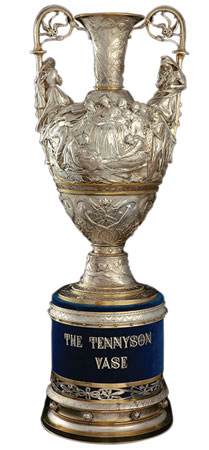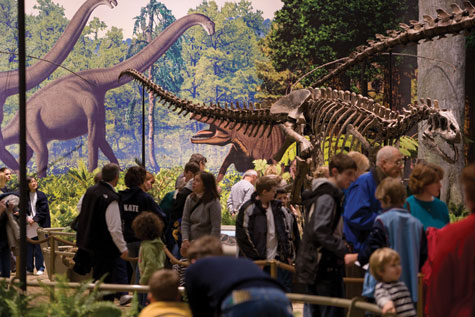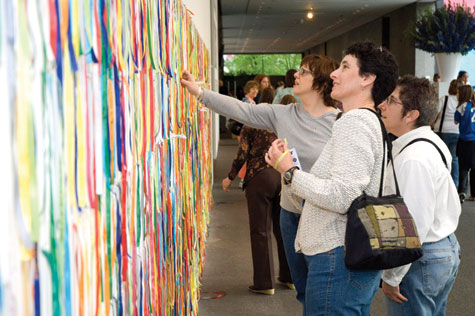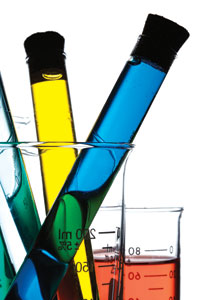 Landing in the “Top 100” Landing in the “Top 100”
One of the art world’s top treasures will add plenty of luster—figuratively and literally—to the reimagined Ailsa Mellon Bruce Galleries, set to reopen this November at Carnegie Museum of Art.
Included on Arts & Antiques magazine’s annual list of 100 noteworthy works of art and design—intended to celebrate significant additions to public art collections—the silver Tennyson Vase has a distinguished pedigree. Designed by sculptor Henry Hugh Armstead, best known for London’s Prince Albert Memorial, and crafted in 1867 by C. F. Hancock and Sons, Queen Victoria’s own silversmiths, the ode-worthy urn was inspired by the works of 19th-century English poet Alfred Lord Tennyson. Specifically, the vase’s figures pay homage to Tennyson’s epic works Morte d’Arthur and Guinevere, depicting none other than King Arthur, his consort queen, and Camelot’s court wizard, Merlin.
An attention-getter from the start, the vase took center stage at the 1867 World’s Fair in Paris, and then again at the 1873 World’s Fair in Vienna. “It’s one of those rare objects that has the ability to transform the museum’s late 19th-century art collection, already a well-known strength in both fine and decorative arts,” says Jason Busch, Carnegie Museum of Art’s Alan G. and Jane A. Lehman Curator of Decorative Arts.
Above: Henry Hugh Armstead (designer), C.F. Hancock & Sons (manufacturer), Tennyson Vase, 1867.
Ailsa Mellon Bruce Fund and Berdan Memorial Trust Fund
Looking like a million

Photo: Josh Franzos
When the turnstiles stopped spinning at the close of 2008, Carnegie Museums of Pittsburgh celebrated an all-time high admissions record, and topped the million mark for the second time in its history.
Last year, more than 1.185 million visitors flocked to a diverse number of “must-see” attractions such as Life on Mars, the 2008 Carnegie International at Carnegie Museum of Art, the final phase of Dinosaurs in Their Time at the Museum of Natural History,
BODIES…The Exhibition at Carnegie Science Center, and the Ron Mueck exhibition at The Warhol.
The Oakland museums posted a whopping 37 percent increase over 2007—attributed in large part to the longest-ever run of the Carnegie International—to reach a new annual record of 386,300 visitors; Carnegie Science Center notched a 27 percent jump with 711,700 visitors; and a 6 percent boost at The Warhol pushed box-office numbers up to 87,400 on-site visits. The previous Carnegie Museums attendance record, set in 2001, logged 1.013 million visitors.
“We’re extremely proud of our accomplishments in 2008,” says David Hillenbrand, president of Carnegie Museums. “Our museums teach, inspire, and bring families and individuals from all backgrounds together for truly memorable experiences.”
 MuTube debuts—for you MuTube debuts—for you
We all know YouTube. Now, there’s MuTube, the latest online discovery tool of Carnegie Museum of Natural History. Created to provide behind-the-scenes access to the museum’s seldom-seen rarities, expansive world-class collections, and fascinating finds by the museum’s renowned scientists, MuTube is a must-see for curious museum-goers. The premiere segment features a three-part journey into what many consider to be one of the museum’s creepiest places—the Alcohol House, home of the herpetology collection, with more than 200,000 salamanders, snakes, frogs, and lizards of all shapes and sizes! Check it out: www.carnegiemnh.org/mutube.
Life on Mars lives on

Photo: Tom Altany
Life on Mars, the 55th installment of the Carnegie International, which closed in early January, was the first to bear a title and, with a seven-month run, the longest ever on view. The summer-to-winter run definitely paid dividends, with more than 279,000 visitors (shared with the Museum of Natural History) experiencing the exhibition that asked: Are we alone in the universe? Or are we, ourselves, the strangers in our own worlds?
One work that resonated with visitors was Rivane Neuenschwander’s I Wish Your Wish, an interactive installation that invited people to take a ribbon with a wish printed on it and replace it with a wish of their own. Among those wishes left behind: I wish it was benign; I wish I could tell my parents I was gay; I wish my life came with a soundtrack; I wish I could take it back. In all, visitors removed more than 120,000 wishes, and, as the installation continues to travel, the wishes made by Pittsburghers will mix with those of Brazilians and Europeans.
Hands down, one of the most curious works—especially in terms of de-installation—was Thomas Hirschhorn’s winding tunnel, Cavemanman. So what happened to all that wood, cardboard, and packing tape? Surprisingly, it came down in sections and was packed away in boxes for future use. The 110 wooden palettes that formed its floor were also recycled.
Seven of the works from Life on Mars are now part of the museum’s permanent collection: Bruce Connor’s photogram Kiss Angel; a painting by Daniel Guzmán; Sharon Lockhart’s photographs Pine Flat Portrait Studio; Thomas Schütte’s sculpture Zombie VIII; David Shrigley’s sculpture Jugs and Cups; and Wolfgang Tillmans’ chromogenic print flower.
 A surplus of generosity A surplus of generosity
In anticipation of its move to its new Lawrenceville campus this spring, Children’s Hospital of Pittsburgh of UPMC gave a welcome parting gift to Oakland neighbor Carnegie Museum of Natural History: laboratory equipment.
When Dr. Edward Prochownik, director of oncology research at Children’s and
a member of the museum’s volunteer group, Carnegie Discoverers, learned the
hospital wouldn’t be taking the surplus equipment to its new site, he teamed up with Carnegie Discoverers’ president Dr. Richard Moriarty to persuade the hospital to make the day of a few researchers at the museum. Children’s did just that with the donation of vacuum pumps, ovens, graduated cylinders, power generators, and other scientific gear to the museum’s ThermoFisher Scientific Molecular Lab.
The equipment will help museum scientists extract and analyze DNA from plant, animal, and fossil specimens—an essential step in investigating evolution and genetic diversity in animal and plant life. “If the museum had to buy this equipment, it would have taken months of fundraising,” says Samuel Taylor, director of the Museum of Natural History. “This partnership is the ultimate in recycling.”
These new Science Center leaders feel right at home

Photo: Renee Rosensteel
Carnegie Science Center has two new leaders, and already they’re right at home in their post. On February 12, Carnegie Museums President David Hillenbrand announced that acting co-directors Ron Baillie and Ann Metzger had been named the new Henry Buhl, Jr. Co-Directors of the Science Center.
“They’re simply an unbeatable combination,” says Hillenbrand. “After an extensive search—and after five months with Ron and Ann at the helm (since the departure of Joanna Haas)—we realized we already had the ideal management team in place. Ann and Ron truly lead by example, and each has extensive ties to our region’s education, business, and medical communities. And each is a passionate advocate of the Science Center mission.”
Baillie, a lifelong educator, is a 25-year veteran of Buhl Planetarium and the Science Center. Most recently, he served as the Science Center’s chief program officer. Metzger came to the Science Center in 2006 as director of marketing and community affairs after a 25-year career at UPMC, where she headed up the health care titan’s communications, marketing, and community outreach efforts.
“I’ve spent the majority of my career committed to moving the vision and mission of the Science Center forward,” says Baillie, “and I eagerly embrace this opportunity to help shape its future.”
“My work with the Science Center has already been the most gratifying of my career,” Metzger says, “and Ron and I are excited to continue working together to build experiences that inspire young people.”
|
 Spring 2009
Spring 2009

 Landing in the “Top 100”
Landing in the “Top 100” 
 MuTube debuts—for you
MuTube debuts—for you 
 A surplus of generosity
A surplus of generosity 